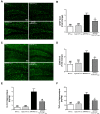CRISPR/Cas9-mediated CysLT1R deletion reverses synaptic failure, amyloidosis and cognitive impairment in APP/PS1 mice
- PMID: 33591941
- PMCID: PMC7993729
- DOI: 10.18632/aging.202501
CRISPR/Cas9-mediated CysLT1R deletion reverses synaptic failure, amyloidosis and cognitive impairment in APP/PS1 mice
Abstract
As a major pathological hallmark of Alzheimer's disease (AD), amyloid-β (Aβ) is regarded as a causative factor for cognitive impairment. Extensive studies have found Aβ induces a series of pathophysiological responses, finally leading to memory loss in AD. Our previous results demonstrated that cysteinyl leukotrienes receptor 1 (CysLT1R) antagonists improved exogenous Aβ-induced memory impairment. But the role of CysLT1R in AD and its underlying mechanisms still remain elusive. In this study, we investigated CysLT1R levels in AD patients and APP/PS1 mice. We also generated APP/PS1-CysLT1R-/- mice by clustered regulatory interspaced short palindromic repeats (CRISPR)/CRISPR-associated protein 9 (Cas9)-mediated CysLT1R deletion in APP/PS1 mice and studied the effect of CysLT1R knockout on amyloidogenesis, synapse structure and plasticity, cognition, neuroinflammation, and kynurenine pathway. These attributes were also studied after lentivirus-mediated knockdown of CysLT1R gene in APP/PS1 mice. We found that CysLT1R knockout or knockdown could conserve synaptic structure and plasticity, and improve cognition in APP/PS1 mice. These effects were associated with concurrent decreases in amyloid processing, reduced neuroinflammation and suppression of the kynurenine pathway. Our study demonstrates that CysLT1R deficiency can mediate several beneficial effects against AD pathogenesis, and genetic/pharmacological ablation of this protein could be a potential therapeutic option for AD.
Keywords: Alzheimer’s disease; amyloidogenesis; cognition; cysteinyl leukotrienes receptor 1; synaptic plasticity.
Conflict of interest statement
Figures







Similar articles
-
Hippocampal CysLT1R overexpression or activation accelerates memory deficits, synaptic dysfunction, and amyloidogenesis in young APP/PS1 transgenic mice.Ann Transl Med. 2021 Oct;9(20):1531. doi: 10.21037/atm-21-4518. Ann Transl Med. 2021. PMID: 34790737 Free PMC article.
-
Microglial Trem2 induces synaptic impairment at early stage and prevents amyloidosis at late stage in APP/PS1 mice.FASEB J. 2019 Sep;33(9):10425-10442. doi: 10.1096/fj.201900527R. Epub 2019 Jun 20. FASEB J. 2019. PMID: 31219699
-
Blockade of adenosine A2A receptors reverses early spatial memory defects in the APP/PS1 mouse model of Alzheimer's disease by promoting synaptic plasticity of adult-born granule cells.Alzheimers Res Ther. 2023 Oct 30;15(1):187. doi: 10.1186/s13195-023-01337-z. Alzheimers Res Ther. 2023. PMID: 37899431 Free PMC article.
-
Novel Multitarget Directed Tacrine Hybrids as Anti-Alzheimer's Compounds Improved Synaptic Plasticity and Cognitive Impairment in APP/PS1 Transgenic Mice.ACS Chem Neurosci. 2020 Dec 16;11(24):4316-4328. doi: 10.1021/acschemneuro.0c00574. Epub 2020 Nov 20. ACS Chem Neurosci. 2020. PMID: 33216529
-
Role and application of CRISPR-Cas9 in the management of Alzheimer's disease.Ann Med Surg (Lond). 2024 Jan 5;86(3):1517-1521. doi: 10.1097/MS9.0000000000001692. eCollection 2024 Mar. Ann Med Surg (Lond). 2024. PMID: 38463115 Free PMC article. Review.
Cited by
-
Application of CRISPR/Cas9 in Alzheimer's Disease.Front Neurosci. 2021 Dec 21;15:803894. doi: 10.3389/fnins.2021.803894. eCollection 2021. Front Neurosci. 2021. PMID: 34992519 Free PMC article. Review.
-
Vector enabled CRISPR gene editing - A revolutionary strategy for targeting the diversity of brain pathologies.Coord Chem Rev. 2023 Jul 15;487:215172. doi: 10.1016/j.ccr.2023.215172. Epub 2023 Apr 20. Coord Chem Rev. 2023. PMID: 37305445 Free PMC article.
-
Applications of CRISPR-Cas9 in Alzheimer's Disease and Related Disorders.Int J Mol Sci. 2022 Aug 5;23(15):8714. doi: 10.3390/ijms23158714. Int J Mol Sci. 2022. PMID: 35955847 Free PMC article. Review.
-
CRISPR/Cas9-Based therapeutics as a promising strategy for management of Alzheimer's disease: progress and prospects.Front Cell Neurosci. 2025 Apr 7;19:1578138. doi: 10.3389/fncel.2025.1578138. eCollection 2025. Front Cell Neurosci. 2025. PMID: 40260080 Free PMC article. Review.
-
Hippocampal CysLT1R overexpression or activation accelerates memory deficits, synaptic dysfunction, and amyloidogenesis in young APP/PS1 transgenic mice.Ann Transl Med. 2021 Oct;9(20):1531. doi: 10.21037/atm-21-4518. Ann Transl Med. 2021. PMID: 34790737 Free PMC article.
References
Publication types
MeSH terms
Substances
LinkOut - more resources
Full Text Sources
Other Literature Sources
Medical
Research Materials

